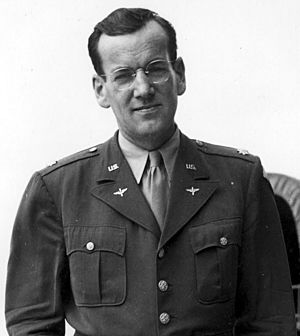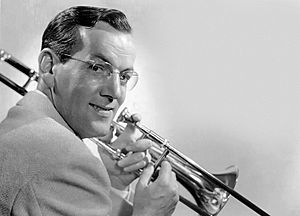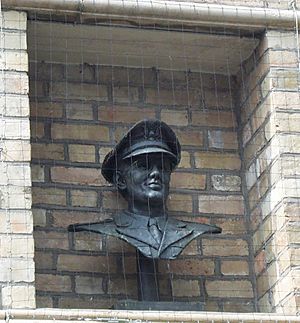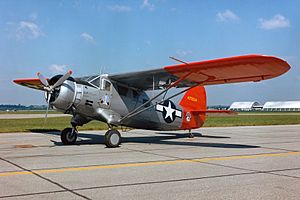Glenn Miller facts for kids
Quick facts for kids
Glenn Miller
|
|
|---|---|

Glenn Miller
|
|
| Background information | |
| Birth name | Alton Glenn Miller |
| Born | March 1, 1904 Clarinda, Iowa, United States |
| Died | December 15, 1944 (aged 40) Plane missing over the English Channel |
| Genres | Swing music, big band |
| Occupation(s) | Bandleader, Musician, Arranger, Composer |
| Instruments | Trombone |
| Years active | 1923–1944 |
| Associated acts | Glenn Miller Orchestra, The Modernaires, Beryl Davis |
Glenn Miller (born March 1, 1904) was a famous American musician, composer, and bandleader. He led a popular "big band" during the "swing era" of music. From 1939 to 1943, his band sold more records than anyone else!
Some of Miller's most famous songs include "In the Mood", "Moonlight Serenade", "Pennsylvania 6-5000", "Chattanooga Choo Choo", and "American Patrol". During World War II, he led bands for the U.S. Army to entertain soldiers. Sadly, his airplane disappeared over the English Channel while he was traveling in France during the war.
Contents
Early Life and Musical Start
Miller was born in Clarinda, Iowa. His parents were Mattie Lou and Lewis Elmer Miller. In 1915, his family moved to Grant City, Missouri. There, Glenn started playing in the town orchestra.
At first, he played the cornet (like a small trumpet) and mandolin. But by 1916, he switched to the trombone. In 1918, his family moved to Fort Morgan, Colorado. Glenn went to high school there.
During his last year of high school, he started a band with his friends. They played "dance band music." By the time he graduated in 1921, Glenn knew he wanted to be a professional musician.
Becoming a Professional Musician
In 1923, Miller went to the University of Colorado at Boulder. But he spent most of his time away from school. He was busy with auditions (try-outs) and gigs (small performances). He didn't do well in school and decided to leave to become a full-time musician.
Later, he studied music with Joseph Schillinger. This is when he composed his famous song "Moonlight Serenade." In 1926, Miller toured with different music groups. He eventually got a good spot in Ben Pollack's band in Los Angeles.
While playing with Pollack's band, Miller wrote many musical arrangements. He also co-wrote his first song, "Room 1411", with another famous musician, Benny Goodman. In 1928, Glenn married Helen Burger in New York City.
At first, Glenn was the main trombone player in the band. But when another trombone player joined, Glenn got fewer solos. This made him decide to focus more on composing music. In the late 1920s, he wrote and published a songbook.
Working with Other Bands
In the early 1930s, Miller worked as a trombonist, arranger, and composer for The Dorsey Brothers. He composed songs like "Annie's Cousin Fannie" and "Harlem Chapel Chimes" in 1934 and 1935.
In 1935, he put together an American orchestra for British bandleader Ray Noble. In this band, he used a special arrangement. He had a lead clarinet playing over four saxophones. He later used this unique sound in his own bands.
Glenn Miller formed his first band in 1937. This band didn't last long. It broke up after its last show on January 2, 1938.
Success with His Own Band: 1938–1942
After his first band broke up, Miller felt discouraged. He went back to New York. He realized his next band needed a special "sound" to stand out. He decided to have the clarinet and tenor saxophone play the main melody together. Three other saxophones would play the harmony.
Miller hired a saxophonist named Wilbur Schwartz. But instead, he had Schwartz play the lead clarinet. This was very unique! It didn't rely on repeating musical ideas like other bands.
Miller also had a team of talented people who wrote and arranged songs for his band. These included Jerry Gray, Bill Finegan, Billy May, and George Williams.
Bluebird Records and Glen Island Casino
In September 1938, the Glenn Miller band started recording music for Bluebird Records. A businessman named Cy Shribman helped pay for the band.
In the spring of 1939, the band played at the Meadowbrook Ballroom in Cedar Grove, New Jersey. They also played at the Glen Island Casino in New Rochelle, New York. At Glen Island, 1,800 people came to see them! After this, the band became much more popular. Their song "Tuxedo Junction" sold 115,000 copies in just one week.
On February 10, 1942, Miller received a gold record for "Chattanooga Choo-Choo". A gold record means a song has sold a lot of copies. "Chattanooga Choo Choo" was performed by Miller's orchestra. It featured singers Gordon "Tex" Beneke, Paula Kelly, and the vocal group, the Modernaires. Other singers with the orchestra included Marion Hutton and Ray Eberle.
Movies with the Band
Glenn Miller and his band appeared in two movies. The first was Sun Valley Serenade in 1941. The second movie was Orchestra Wives in 1942.
Army Air Force Band: 1942–1944
In 1942, Miller wanted to help with the war effort. He was too old to be drafted into the military. First, he volunteered for the Navy, but they said they didn't need him.
Then, Miller wrote to Army Brigadier General Charles Young. He asked to lead an army band. He wanted to entertain the Allied Forces (the soldiers fighting against Germany and Japan). This time, he was accepted! He became a captain and was later promoted to major in August 1944.
He was first in the United States Army. Then he moved to the Army Air Forces. Captain Glenn Miller served as an officer at a training center in Maxwell Air Force Base in Montgomery, Alabama. This was in December 1942. He played trombone with a 15-piece dance band called the Rhythmaires. They played on the base and in town.
Miller formed a large marching band. He wanted to make military music more modern. Some officers didn't like his ideas. But he kept going because other leaders supported him. For example, he mixed blues and jazz music with traditional military marches.
He formed the Army Air Force Band, which had 50 members. In the summer of 1944, he took the band to England. There, they gave 800 performances! They also recorded many songs. Their music was played on American Forces Network radio. This helped entertain soldiers and spread messages against fascism.
Miller also spoke on the radio. One time, he said:
"America means freedom and there's no expression of freedom quite so sincere as music."
Disappearance

On December 15, 1944, Miller was supposed to fly from the United Kingdom to Paris, France. He was going to play for the soldiers there. His plane left from Clapham. It then disappeared while flying over the English Channel. There were two other people on the plane: Lt. Col. Norman Baessell and the pilot John Morgan.
Many ideas have been shared about what happened to the plane. A 2014 article in the Chicago Tribune suggested that Miller's plane crashed because it had a faulty carburetor (a part of the engine).
In February 1945, Miller's wife, Helen, accepted the Bronze Star Medal for him. This is a military award for bravery.
Glenn Miller's Legacy
His Civilian Band's Influence
When Glenn Miller was alive, other bandleaders, like Bob Chester, tried to play music in his style. In 1942, Miller even gave advice to singer Mel Tormé about writing songs.
By the early 1950s, more bands started to copy Miller's unique sound.
After Glenn Miller disappeared, his family allowed an official Glenn Miller "ghost band" to be formed in 1946. This band was led by Tex Beneke. He was a former tenor saxophonist and singer for Miller's original band. This new band was similar to Miller's Army Air Force Band because it had a large string section. At first, it was called "The Glenn Miller Orchestra Under the Direction of Tex Beneke." Later, it became "The Tex Beneke Orchestra."
A movie about Miller's life, The Glenn Miller Story, came out in 1953. Because of this movie, Miller's family asked Ray McKinley to lead a new ghost band in 1956. This band still tours the United States today!
His Army Air Force Band's Influence
After Miller disappeared, his Army Air Force band was sent back to the United States. Another band, called "the 314," took its place.
Songs Composed by Miller
Miller composed at least fourteen songs, either by himself or with other people. He also added lyrics to another song. These songs and others were recorded by Miller's civilian bands and his Army Air Force band.
Grammy Hall of Fame
Three of Glenn Miller's recordings were put into the Grammy Hall of Fame after he died. This award is for recordings that are at least 25 years old. They must also have "qualitative or historical significance," meaning they are very important or special.
| Glenn Miller: Grammy Hall of Fame Awards | |||||
| Year Recorded | Title | Genre | Label | Year Inducted | Notes |
|---|---|---|---|---|---|
| 1939 | "Moonlight Serenade" | Jazz (single) | RCA Bluebird | 1991 | |
| 1941 | "Chattanooga Choo Choo" | Jazz (single) | RCA Bluebird | 1996 | |
| 1939 | "In the Mood" | Jazz (single) | RCA Bluebird | 1983 | |
Related pages
Images for kids
See also
 In Spanish: Glenn Miller para niños
In Spanish: Glenn Miller para niños








